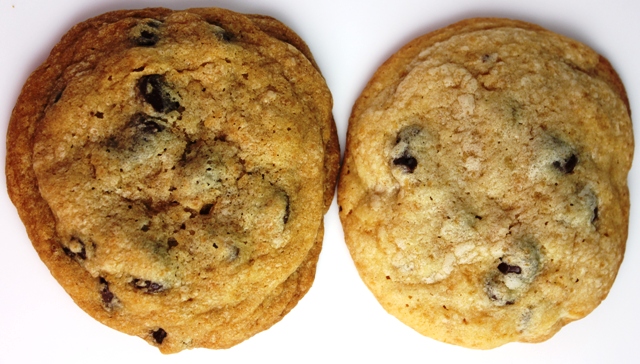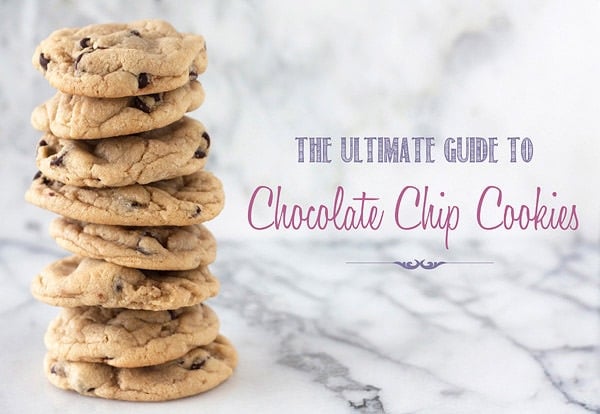The Experiment
Many people have trouble baking chocolate chip cookies according to their preferences. Some like them quite crispy, some like them chewy; some like them fluffy like cake and some like them chock full of brown sugar. We're going to find out how to adjust the original Nestle Tollhouse Cookie recipe to fit your tastebuds! This experiment is based on the series of experiments by Handle The Heat.
Materials:
Copious quantities of flour, sugar/brown sugar, eggs, butter/shortening/margarine, salt, vanilla, chocolate chips, baking soda/baking powder.
Control Recipe - Nestle Tollhouse Chocolate Chip Cookies
YIELD: About 22 cookies
Ingredients:
1 cup plus 2 tablespoons (5 ounces or 142 grams) all-purpose flour
1/2 teaspoon baking soda
1/2 teaspoon salt
1 stick (4 ounces) unsalted butter, at room temperature
1/4 cup plus 2 tablespoons granulated sugar
1/4 cup plus 2 tablespoons packed brown sugar
1/2 teaspoon vanilla
1 large egg
1 cup semi sweet chocolate chips
1/2 teaspoon baking soda
1/2 teaspoon salt
1 stick (4 ounces) unsalted butter, at room temperature
1/4 cup plus 2 tablespoons granulated sugar
1/4 cup plus 2 tablespoons packed brown sugar
1/2 teaspoon vanilla
1 large egg
1 cup semi sweet chocolate chips
Directions:
Preheat oven to 350°F. Line baking sheets with nonstick baking mats or parchment paper.
In a medium bowl combine the flour, baking soda, and salt.
In the bowl of an electric mixer beat the butter, granulated sugar, and brown sugar until creamy, about 2 minutes. Add the egg and vanilla, beating well to combine. Gradually beat in the flour mixture. Stir in the chocolate chips. Scoop 1 1/2 tablespoon-sized balls and place onto prepared baking sheets.
Bake for 9 to 11 minutes, or until golden brown. Cool for 2 minutes before removing to wire racks to cool completely.
If you want to bake smaller batches for experimenting, then cut the recipe in half again! It might be a little tougher because you would need half an egg, but we believe in you all.
Try it out:
1. Bake one batch of the original Nestle Tollhouse cookies as a control, so that you can compare the rest of your cookies to them. Taste-test. Take a picture of one of the cookies afterwards.
2. Choose from the adjustments below and bake the recipe adjusted as specified. Taste-test. Take a picture of one of the cookies afterwards.
3. Repeat as many times as you have ingredients, or as many times as you're allowed to.
Adjustments to try:
Baking powder instead of baking soda: will yield doughy tasting cookies
3/4 cups granulated sugar (no brown sugar): cookies won't have as much flavor, and will be quite flat
3/4 cups brown sugar (no granulated sugar): cookies will be thick and soft and have strong butterscotch flavor
Cream butter for 5 minutes: Yields flatter and lighter cookies
What's happening
Although this seems like just a poorly veiled excuse to bake lots and lots of cookies, there is science behind each adjustment!
For example, baking soda is actually a chemical with basic properties called sodium bicarbonate, or NaHCO3. It releases carbon dioxide when reacting with an acidic substance, such as the brown sugar in chocolate chip cookies. This helps to add texture to the cookies. Baking powder contains baking soda, however for the acid, it contains one acid that will react with the baking soda at room temperature, usually MCP, and a different one that only melts at high temperatures (i.e. while baking), such as SAS. This is why baking powder is used more often for cakes and muffins, while baking soda is used more for cookies - baking soda gives a browner color and more caramelized flavor to baked goods.
This is also the reason the pure granulated sugar cookies are much flatter than cookies with brown sugar in them. Granulated sugar is not acidic at all, and therefore won't react with the baking soda to give the cookies that lift.
Sugar is made by heating the sap of sugar cane. This process forms molasses with sugar crystals, which is spun in a centrifuge (a machine which separates things by weight by spinning them really quickly) to get white sugar and the molasses separated. Brown sugar is made by mixing the white sugar and molasses back together, making a moister product than white sugar.
Since brown sugar is moister than white sugar, using it as a substitute will make recipes softer and brown darker. It's probably a good idea to reduce the amount of other wet ingredients if you are using brown sugar as a substitute.
When you cream butter, you introduce air bubbles into it. The purpose of creaming butter for cookies is to properly mix the sugar into them, however if you cream them for too long, the cookies won't be as dense and flavor packed.
For example, baking soda is actually a chemical with basic properties called sodium bicarbonate, or NaHCO3. It releases carbon dioxide when reacting with an acidic substance, such as the brown sugar in chocolate chip cookies. This helps to add texture to the cookies. Baking powder contains baking soda, however for the acid, it contains one acid that will react with the baking soda at room temperature, usually MCP, and a different one that only melts at high temperatures (i.e. while baking), such as SAS. This is why baking powder is used more often for cakes and muffins, while baking soda is used more for cookies - baking soda gives a browner color and more caramelized flavor to baked goods.
 |
| Baking soda on the left, baking powder on the right |
Sugar is made by heating the sap of sugar cane. This process forms molasses with sugar crystals, which is spun in a centrifuge (a machine which separates things by weight by spinning them really quickly) to get white sugar and the molasses separated. Brown sugar is made by mixing the white sugar and molasses back together, making a moister product than white sugar.
Since brown sugar is moister than white sugar, using it as a substitute will make recipes softer and brown darker. It's probably a good idea to reduce the amount of other wet ingredients if you are using brown sugar as a substitute.
When you cream butter, you introduce air bubbles into it. The purpose of creaming butter for cookies is to properly mix the sugar into them, however if you cream them for too long, the cookies won't be as dense and flavor packed.
If you thought this was cool...
There are many more experiments you can try with the cookies, as can be seen on the original experimenter's website here! Sprinkled throughout her cookie reports are many more suggestions she makes that she didn't try baking that you can try yourself.



No comments:
Post a Comment